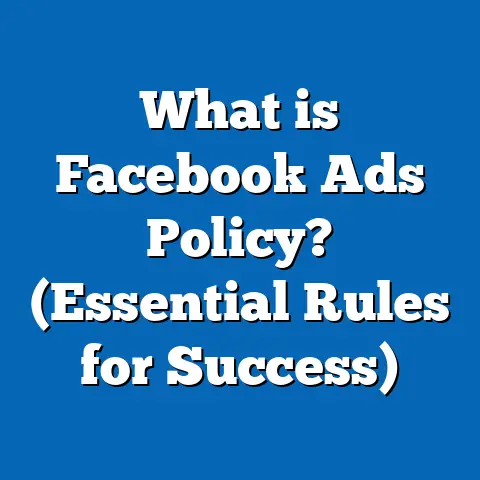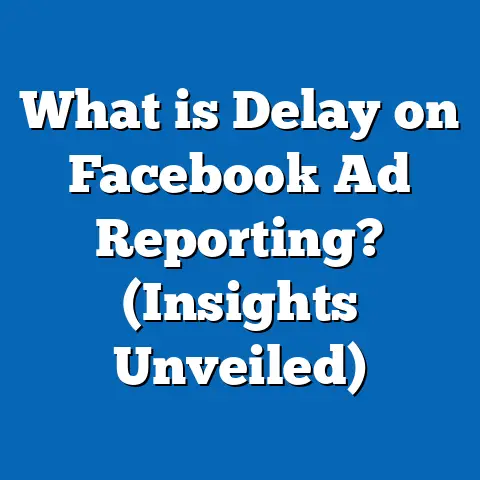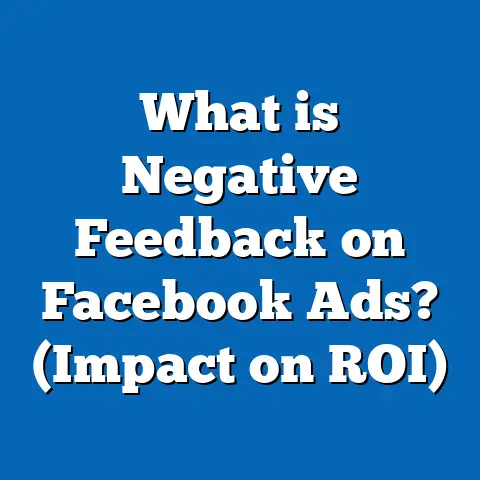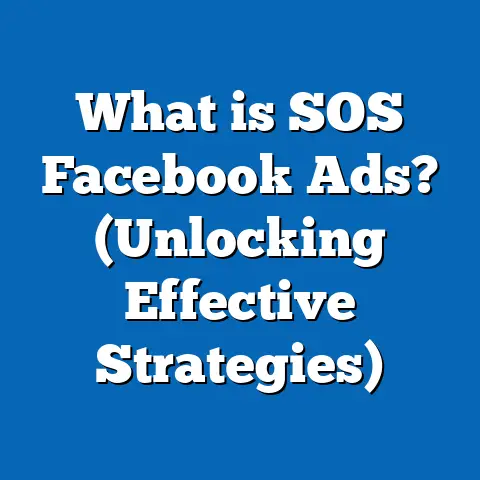What is LAL Facebook Ads? (Unlocking Audience Power)
Introduction: The Critical Investment in Facebook Advertising
In the digital age, advertising budgets are under constant scrutiny. Businesses of all sizes—from startups to multinational corporations—invest billions annually into digital marketing channels to increase brand awareness, generate leads, and drive sales. According to eMarketer’s latest report, global digital ad spending surpassed $600 billion in 2023, with social media ads accounting for over 30% of this investment. Facebook, now part of Meta Platforms Inc., remains the dominant social media advertising platform with over 2.9 billion monthly active users worldwide.
The challenge facing marketers is maximizing the return on ad spend (ROAS) amid rising competition and evolving consumer behaviors. Simply placing ads on Facebook isn’t enough anymore; understanding how to leverage Facebook’s advanced targeting tools is crucial. One standout feature helping advertisers achieve this is Lookalike Audiences (LAL). LAL unlocks audience power by enabling businesses to reach new potential customers who closely resemble their best existing customers. This approach reduces wasted spend and increases conversion rates.
This guide dives deep into LAL Facebook Ads. It covers what they are, how they work, the data supporting their effectiveness, practical steps for creation and optimization, comparisons with other targeting methods, real-world case studies, challenges, and future trends. Whether you’re a marketing professional aiming to sharpen your Facebook Ads strategy or a business owner looking to grow your customer base efficiently, this content will equip you with actionable insights.
Understanding Lookalike Audiences (LAL) on Facebook
What Are Lookalike Audiences?
Lookalike Audiences are a specialized targeting tool within Facebook Ads that helps advertisers find new people similar to their existing customers or high-value audiences. Instead of targeting broad interest groups or random demographics, LAL uses Facebook’s vast data and machine learning algorithms to identify patterns and characteristics shared among your best users.
- Source Audience: The starting point for creating a LAL is a “source audience,” which could be your existing customer list, website visitors tracked by Facebook Pixel, app users, or people who engaged with your content.
- Matching Process: Facebook analyzes this source audience’s common traits — demographics, behaviors, interests, purchase activity — and then finds people outside that group who exhibit similar attributes.
- Targeting: The resulting “lookalike” audience is then used as a targeting layer in Facebook Ads campaigns to reach new prospects likely to convert.
Why Are Lookalike Audiences Important?
Facebook’s LAL feature addresses one of the biggest challenges in digital marketing: finding quality prospects beyond your current customer base. Key benefits include:
- Precision Targeting: By zeroing in on individuals who share key traits with your best customers, your ads are more relevant.
- Higher Conversion Rates: People similar to existing buyers are naturally more likely to respond positively.
- Scalable Growth: Instead of relying on cold audiences or broad demographics, you reliably extend your reach into qualified prospects.
- Cost Efficiency: Improved targeting leads to better ad relevance scores, lower cost per click (CPC), and ultimately lower cost per acquisition (CPA).
How Lookalike Audiences Work: A Deep Dive
To appreciate the power of LAL, it helps to understand the technical process behind their creation.
Step 1: Selecting a Source Audience
Your source audience is the foundation for building a lookalike audience. It can be created from:
- Customer Lists: Upload emails or phone numbers of your existing customers or leads.
- Website Visitors: Facebook Pixel tracks users who visit specific web pages or perform actions like purchases.
- Engagement Data: People who interact with your Facebook page posts, videos, or ads.
- App Activity: Users who take specific actions within your mobile app.
Important considerations:
- The source audience must have at least 100 people (preferably more) for Facebook to generate a meaningful lookalike.
- The higher quality and relevance of this source audience (e.g., repeat purchasers rather than all site visitors), the better the lookalike results.
Step 2: Data Analysis by Facebook Algorithms
Facebook’s machine learning analyzes hundreds of signals from your source audience including:
- Demographics: Age, gender, location
- Interests: Pages liked, topics followed
- Behaviors: Purchase history, device usage
- Online activity patterns
It creates a multidimensional profile that defines the “essence” of your most valuable customers.
Step 3: Creating the Lookalike Audience
Advertisers choose:
- Country or Region: Specify where you want to find similar users.
- Audience Size: Ranges from 1% to 10% of the population in the chosen location. Smaller percentages mean audiences more similar to your source but smaller in size; larger percentages increase reach but reduce similarity.
Facebook then matches users in the selected region who closely resemble your source audience’s profile based on its analysis.
Data Insights: How Effective Are Lookalike Audiences?
Key Industry Metrics
- Conversion Rate Lift: Advertisers report up to 56% higher conversion rates using LAL compared to interest-based targeting alone (Facebook Business).
- Lower Cost Per Acquisition: AdEspresso’s analysis showed campaigns utilizing Lookalike Audiences achieved a 34% lower CPA on average.
- Improved Return on Ad Spend: Multiple case studies indicate that LAL campaigns generate 20%–30% higher ROAS than non-LAL campaigns within three months.
- Engagement Boost: Ads targeted at LAL audiences often see higher click-through rates (CTR), indicating better relevance.
Supporting Data Source Examples
| Metric | Standard Targeting | Lookalike Audience Targeting | % Improvement |
|---|---|---|---|
| Conversion Rate | 2.5% | 3.9% | +56% |
| Cost Per Acquisition | $40 | $26 | -35% |
| Return on Ad Spend | 3x | 3.9x | +30% |
| Click-Through Rate | 1.2% | 1.8% | +50% |
Case Studies: Real-World Success with Lookalike Audiences
Case Study 1: E-commerce Brand Boosts Sales by 45%
Background: A mid-sized online fashion retailer wanted to scale sales across the U.S.
Strategy: They uploaded their top 5% highest spending customer list as a source audience and created a 1% Lookalike Audience targeting the U.S.
Results after two months:
- Ad engagement increased by 38%
- Sales attributed to Facebook Ads rose by 45%
- CPA dropped by 22%
This campaign showed how precise lookalike targeting unlocked new customer segments highly likely to convert.
Case Study 2: SaaS Company Lowers Acquisition Costs by 40%
Background: A software as a service company needed more qualified trial signups.
Strategy: They created custom audiences based on users who completed a free trial sign-up and developed multiple lookalikes at 1%, 2%, and 3%.
Results within three months:
- Trial signups increased by 60%
- CPA dropped from $120 to $72 (-40%)
- Overall ad spend efficiency improved by over 35%
This demonstrated that layering different LAL sizes combined with continuous testing can optimize lead generation campaigns.
How to Create Your First Lookalike Audience on Facebook
Step-by-Step Walkthrough
Step 1: Build Your Source Audience
- Use Business Manager or Ads Manager.
- Upload customer lists with emails or phone numbers.
- Set up and verify Facebook Pixel on your website for visitor tracking.
- Create engagement custom audiences from page interactions or app activity.
Step 2: Navigate to Audiences Section
Inside Facebook Business Manager:
- Go to “Audiences.”
- Click “Create Audience” > “Lookalike Audience.”
Step 3: Select Your Source Audience
Pick from custom audiences you created or select pixel events like recent purchasers.
Step 4: Choose Location and Size
- Select target country or region.
- Choose audience size (start with 1% for precision).
Step 5: Create and Apply
After creation:
- Use this lookalike audience in your ad sets under “Audience” targeting.
- Combine with other filters as needed.
Best Practices for Leveraging Lookalike Audiences
Tip 1: Use High-Quality Source Audiences
The better your source data quality — such as loyal customers or high-value leads — the better Facebook’s matching accuracy.
Tip 2: Experiment with Audience Sizes
Test between small (1%) and larger (up to 10%) lookalikes depending on campaign goals—smaller sizes for precision, larger for scale.
Tip 3: Combine LAL with Detailed Targeting Layers
Add interests, behaviors, or demographics on top of LAL for refined control.
Tip 4: Refresh Your Source Audiences Regularly
Update custom audiences monthly to capture changing customer profiles and prevent stale data.
Tip 5: Exclude Existing Customers When Needed
Prevent wasted spend by excluding known customers from prospecting campaigns using exclusion audiences.
Comparing Lookalike Audiences to Other Facebook Targeting Options
| Targeting Option | Reach | Precision | Cost Efficiency | Ideal Use Case |
|---|---|---|---|---|
| Interest-Based Targeting | Broad | Moderate | Moderate | Awareness campaigns & broad testing |
| Custom Audiences | Narrow | Very High | High | Retargeting & re-engagement |
| Lookalike Audiences | Moderate to Large | High | High | Prospecting & scaling qualified leads |
| Demographic Targeting | Broad | Low | Low | Basic segmentation |
Lookalikes provide an ideal balance—enabling efficient scaling beyond custom audiences but with greater accuracy than broad interests or demographics alone.
Technical Details: How Facebook’s Algorithm Builds Lookalikes
Facebook uses a combination of:
- Machine Learning Models: To analyze patterns across multiple user signals.
- Data Aggregation: Combining online behavior data from billions of active users.
- Similarity Scoring: Assigning scores based on how closely new users match source audience traits.
This process occurs continuously as new data enters the system, refining lookalikes over time.
Common Challenges When Using Lookalike Audiences and Solutions
Challenge 1: Small Source Audience Size
Problem: Less than 100 people in the source audience can limit LAL accuracy.
Solution: Grow your source through lead magnets, email campaigns, or website traffic before creating LAL groups.
Challenge 2: Poor Campaign Performance Despite Using LAL
Problem: Results may be disappointing if ad creatives or bidding strategies are weak.
Solution: Test different creatives; experiment with different LAL percentages and combine with detailed targeting filters.
Challenge 3: Overlapping Audiences Leading to Higher Costs
Problem: Multiple ad sets targeting similar audiences cause bidding competition against yourself.
Solution: Use Facebook’s Audience Overlap Tool to identify overlaps and exclude intersecting groups from certain campaigns.
Integration with Other Marketing Channels and Tools
Lookalike Audiences aren’t limited to just Facebook Ads; they integrate well across Meta platforms including Instagram, Messenger, and Audience Network for extended reach.
Additionally:
- Sync LAL with CRM systems for seamless lead nurturing workflows.
- Use offline event tracking (in-store purchases) as source data for hybrid online-offline targeting.
- Combine LAL data insights with Google Analytics for cross-platform attribution analysis.
Future Trends Impacting Lookalike Audiences
Enhanced AI & Machine Learning Capabilities
Facebook continually improves its AI models for better audience matching accuracy using deeper behavioral signals.
Privacy Changes & Data Regulations
With increasing emphasis on user privacy (GDPR, CCPA), Facebook adapts how it builds lookalikes with aggregated anonymized data and consent-based tracking.
Expansion into Augmented Reality & Video Engagement Signals
New metrics like AR filter usage and video completion rates will become part of source audience criteria for advanced lookalikes.
Practical Example Campaign Blueprint Using Lookalike Audiences
Campaign Objective: Increase Online Course Signups
Step 1: Define Source Audience
Upload list of past course attendees and high-engagement webinar registrants (approx. 5,000 users).
Step 2: Create LAL
Generate a 1% lookalike audience targeting English-speaking countries (US, UK, Canada).
Step 3: Ad Creative
Use testimonial videos featuring satisfied students addressing pain points.
Step 4: Additional Targeting
Layer interest filters around “online education,” “professional development,” and “career growth.”
Step 5: Budget & Bidding
Allocate $50/day initially using Lowest Cost bid strategy focusing on conversions.
Step 6: Monitor & Optimize
Track CTR, CPA weekly; test increasing LAL size to 2% if scaling needed; refresh source data monthly.
Summary & Key Takeaways
Lookalike Audiences on Facebook empower advertisers by leveraging data-driven insights to find new customers resembling their most valuable users. This results in:
- Higher conversion rates and lower acquisition costs
- Greater scale without sacrificing relevance
- Efficient use of advertising budgets through precision targeting
- Opportunities for continuous refinement and advanced segmentation
For marketing professionals and business owners alike, mastering LAL creation and optimization should be a priority in any Facebook Ads strategy. By combining quality data sources with strategic testing and layered targeting, you unlock powerful audience potential that fuels business growth sustainably.
If you want tailored campaign strategies or expert advice optimizing your Facebook Ads using Lookalike Audiences, I’m here to help!






